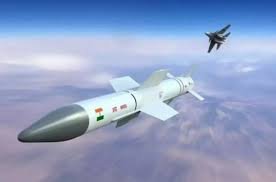Indian Air Force Approves Production of Astra Mark 1 Missiles
Introduction
The Indian Air Force (IAF) has recently approved the production of the Astra Mark 1 missiles. This development marks a significant milestone in India’s defense capabilities and reflects the nation’s growing self-reliance in military technology.
Indigenous Missile Development
The Astra Mark 1 is an indigenous Beyond Visual Range (BVR) air-to-air missile developed by the Defence Research and Development Organisation (DRDO). The approval for its production underscores India’s commitment to advancing its homegrown defense technology and reducing dependency on foreign weaponry.
Key Features of Astra Mark 1
The Astra Mark 1 missile boasts several advanced features, including a range of over 100 kilometers, high single-shot kill probability, and advanced guidance and navigation systems. These features enable the missile to accurately engage and destroy enemy targets at long distances, enhancing the IAF’s operational effectiveness.
Strategic Importance
The induction of Astra Mark 1 missiles is strategically important for India. It enhances the IAF’s air combat capabilities, providing a significant edge over potential adversaries. The missile’s integration with various fighter jets, including the Sukhoi-30MKI, Mirage 2000, and Tejas, will bolster India’s air defense network.
Boost to Make in India Initiative
The approval for the production of Astra Mark 1 aligns with the Government of India’s “Make in India” initiative. It showcases India’s progress in achieving self-reliance in defense production and highlights the capabilities of Indian defense scientists and engineers.
Conclusion
The IAF’s approval of Astra Mark 1 missile production is a landmark achievement in India’s defense sector. It not only strengthens the nation’s defense capabilities but also promotes indigenous technological advancements.
Why This News is Important
Enhancing National Security
The production of Astra Mark 1 missiles significantly enhances India’s national security. By equipping the IAF with advanced BVR air-to-air missiles, the country can better defend its airspace and maintain a strategic advantage over potential threats.
Promoting Self-Reliance
This development is a testament to India’s growing self-reliance in defense technology. The successful development and production of indigenous missiles reduce the country’s dependency on foreign military suppliers, fostering a more self-sufficient defense industry.
Boosting Defense Capabilities
The integration of Astra Mark 1 missiles with various fighter jets boosts the IAF’s overall combat capabilities. The missile’s advanced features, such as high accuracy and long-range engagement, provide a critical advantage in aerial warfare scenarios.
Supporting the Make in India Initiative
The approval aligns with the Make in India initiative, highlighting the progress made in domestic defense production. It showcases the capabilities of Indian scientists and engineers, encouraging further investments in indigenous defense technologies.
Strategic Deterrence
The induction of Astra Mark 1 missiles serves as a strategic deterrent against potential adversaries. It sends a strong message about India’s enhanced defense preparedness and its ability to safeguard national interests.
Historical Context
Development of Astra Missiles
The development of Astra missiles began in the early 2000s as part of India’s efforts to modernize its military capabilities. The DRDO has been instrumental in the research and development of these missiles, aiming to create a reliable and effective air-to-air combat solution.
Previous Missile Programs
India has a history of successful missile programs, including the Prithvi and Agni series of ballistic missiles. The Astra Mark 1 represents the latest advancement in this lineage, focusing specifically on air-to-air combat and enhancing the IAF’s operational capabilities.
Integration with Indian Fighter Jets
Over the years, the Astra Mark 1 has undergone extensive testing and integration with various Indian fighter jets. This process ensured that the missile met the rigorous standards required for operational deployment, culminating in the recent approval for production.
Key Takeaways from Indian Air Force Approves Production of Astra Mark 1 Missiles
| Serial Number | Key Takeaway |
|---|---|
| 1 | Astra Mark 1 is an indigenous BVR air-to-air missile developed by DRDO. |
| 2 | The missile has a range of over 100 kilometers and high accuracy. |
| 3 | It enhances the IAF’s air combat capabilities and strategic deterrence. |
| 4 | The approval aligns with India’s Make in India initiative. |
| 5 | It promotes self-reliance in defense technology and reduces dependency on foreign suppliers. |
Important FAQs for Students from this News
1. What is the Astra Mark 1 missile?
- The Astra Mark 1 is an indigenous Beyond Visual Range (BVR) air-to-air missile developed by the Defence Research and Development Organisation (DRDO). It is designed to engage and destroy enemy aircraft at long distances.
2. What are the key features of the Astra Mark 1 missile?
- Key features of the Astra Mark 1 include a range of over 100 kilometers, high accuracy, advanced guidance and navigation systems, and the ability to be integrated with various fighter jets.
3. How does the Astra Mark 1 enhance India’s defense capabilities?
- The Astra Mark 1 enhances India’s defense capabilities by improving the Indian Air Force’s air combat effectiveness, providing long-range engagement options, and serving as a strategic deterrent against potential adversaries.
4. How does the approval of Astra Mark 1 production align with the Make in India initiative?
- The production approval for Astra Mark 1 supports the Make in India initiative by showcasing India’s progress in domestic defense production, highlighting the capabilities of Indian scientists and engineers, and reducing dependency on foreign military equipment.
5. Which fighter jets will integrate the Astra Mark 1 missile?
- The Astra Mark 1 missile will be integrated with various Indian fighter jets, including the Sukhoi-30MKI, Mirage 2000, and Tejas.

